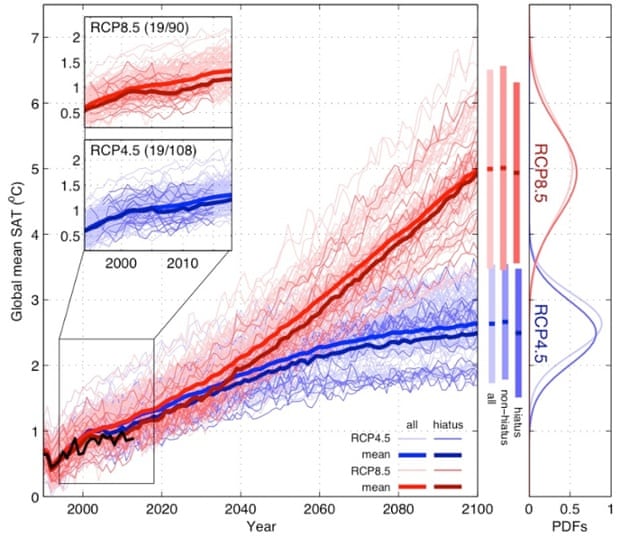
Since the turn of the century, the Earth’s climate has continued to accumulate heat at a rate equivalent to more than 4 atomic bomb detonations per second. During that time, the warming rate of the Earth’s surface temperatures (which represent about 1–2% of the overall warming of the Earth’s climate) has slowed somewhat.
That surface warming slowdown has been inaccurately named ‘the pause,’ and has been the basis of arguments that we needn’t worry about climate change. In reality, there’s no statistical evidence that we’ve deviated from the long-term surface warming trend observed over the past 40–50 years. Stefan Rahmstorf, who has researched recent global surface temperature changes, told me,
There is no change in the global warming trend. We’re just looking at random variability around a steady warming trend. And this random variability has been there all along, it’s not a recent change.
There’s also no evidence that our expectations of future global warming are inaccurate. For example, a paper published in Nature Climate Change last week by a team from the University of New South Wales led by Matthew England showed that climate models that accurately captured the surface warming slowdown (dark red & blue in the figure below) project essentially the same amount of warming by the end of the century as those that didn’t (lighter red & blue).

Surface temperature changes projected by climate models that do (darker colors) and don’t (lighter colors) capture the surface warming slowdown. Red represents temperature projections under a business-as-usual high-emissions scenario (RCP8.5; red) and a scenario where humans take some action to reduce carbon pollution (RCP4.5; blue). Source: Nature Climate Change; England et al. 2015.
There’s also been substantial climate research examining the causes behind the short-term surface warming slowdown. Essentially it boils down to a combinationof natural variability storing more heat in the deep oceans, and an increase in volcanic activity combined with a decrease in solar activity. These are all temporary effects that won’t last. In fact, we may already be at the cusp of an acceleration in surface warming, with 2014 being a record-hot year and 2015 on pace to break the record yet again.
However, contrarians have pounced on the slowdown to support the case for climate inaction. For example, Christopher Monckton, Willie Soon, David Legates, and William Briggs published a paper in a Chinese journal Science Bulletin using an “irreducibly simple climate model” to claim that “combustion of all recoverable fossil fuels will cause < 2.2 K global warming to equilibrium.” If that were true, we could continue burning fossil fuels with little concern about dangerous climate consequences.
Their argument was based on the false premise that climate models have badly overestimated global warming by failing to reproduce the surface warming slowdown. However, Science Bulletin has accepted a paper detailing the errors in Monckton et al. authored by myself, John Abraham, and our colleagues. We identified a litany of mistakes in their paper, including an exaggeration of the discrepancy between model projections and recent temperature observations; a subject detailed in my recently-published book and our Denial101x course.
Monckton et al. then created a model based on how electronic circuits are designed, rather than on the physics and chemistry of the Earth’s climate. They effectively used circular logic, showing that the climate is insensitive to the increased greenhouse effect by using a model that assumed the climate is insensitive to the increased greenhouse effect. As my colleagues and I show in our paper, mainstream climate models reproduce observed temperature changes much more accurately than the Monckton et al. model.
Similarly, in her recent testimony before the US House of Representatives Committee on Science, Space and Technology, contrarian climate scientist Judith Curry cited the “hiatus in global warming since 1998” and claimed “climate models predict much more warming than has been observed in the early 21stcentury” to cast doubt on human-caused global warming and associated threats and policy solutions.
As climate scientist Michael Mann and I recently wrote, the ‘pause’ has become more of a political issue than a scientific one. All evidence indicates that the causes of the surface warming slowdown are temporary, that the Earth is still accumulating heat at an exceptionally rapid rate, and that surface warming will soon accelerate. Although they don’t yet capture short-term variability accurately, we have no reason to doubt climate models’ long-term global warming projections, which are dominated by the growing global energy imbalance caused by the increasing greenhouse effect.
Posted by dana1981 on Wednesday, 6 May, 2015
 |
The Skeptical Science website by Skeptical Science is licensed under a Creative Commons Attribution 3.0 Unported License. |